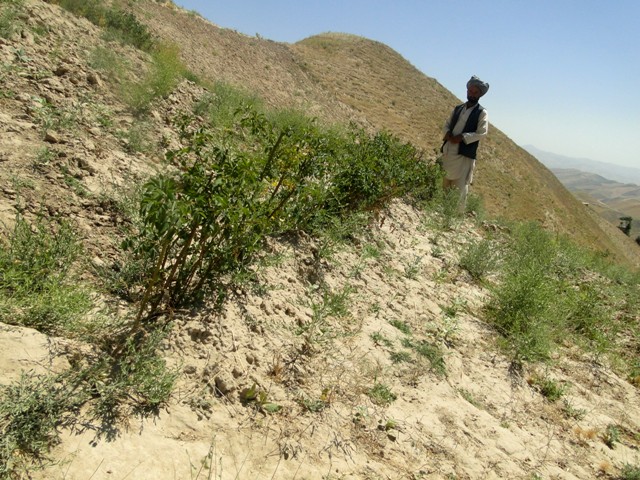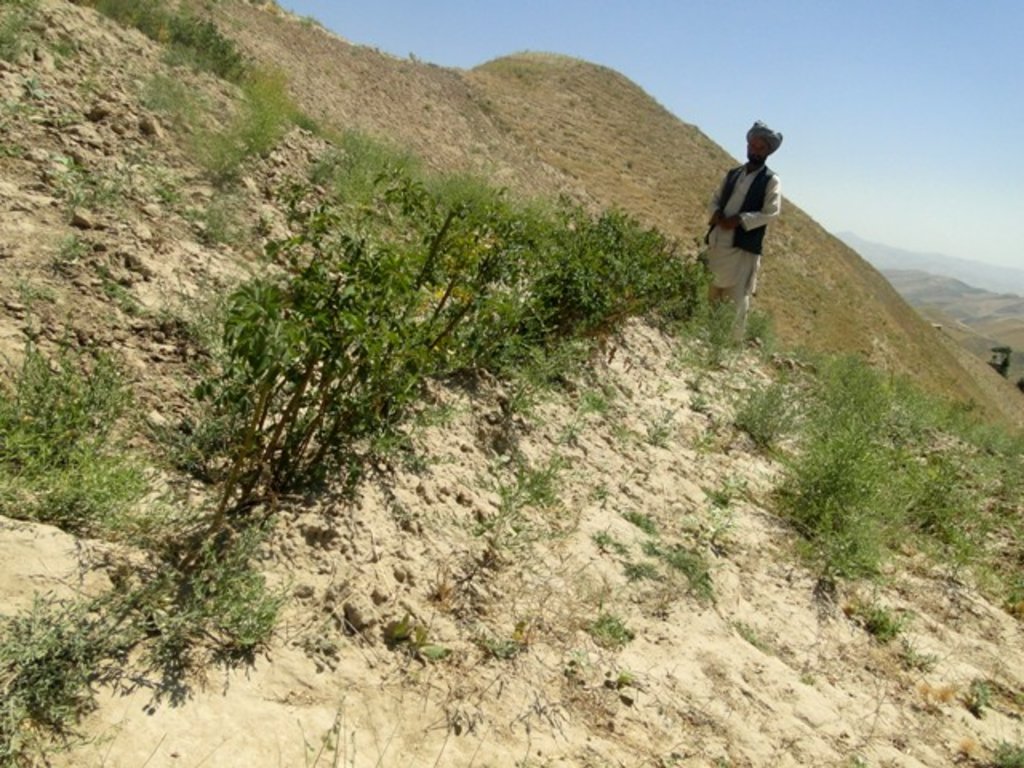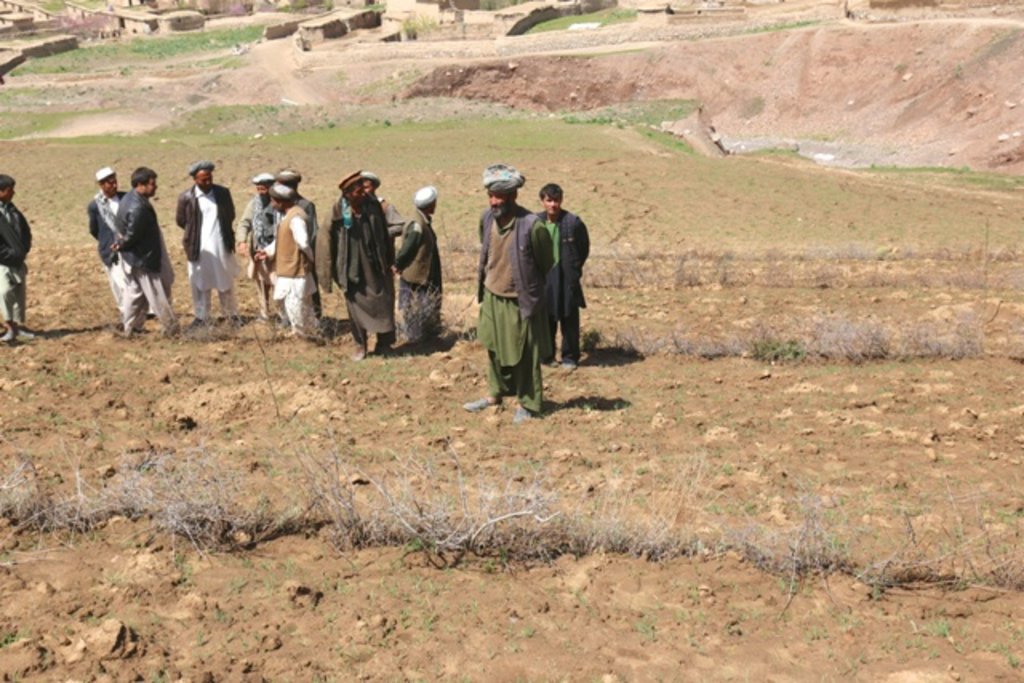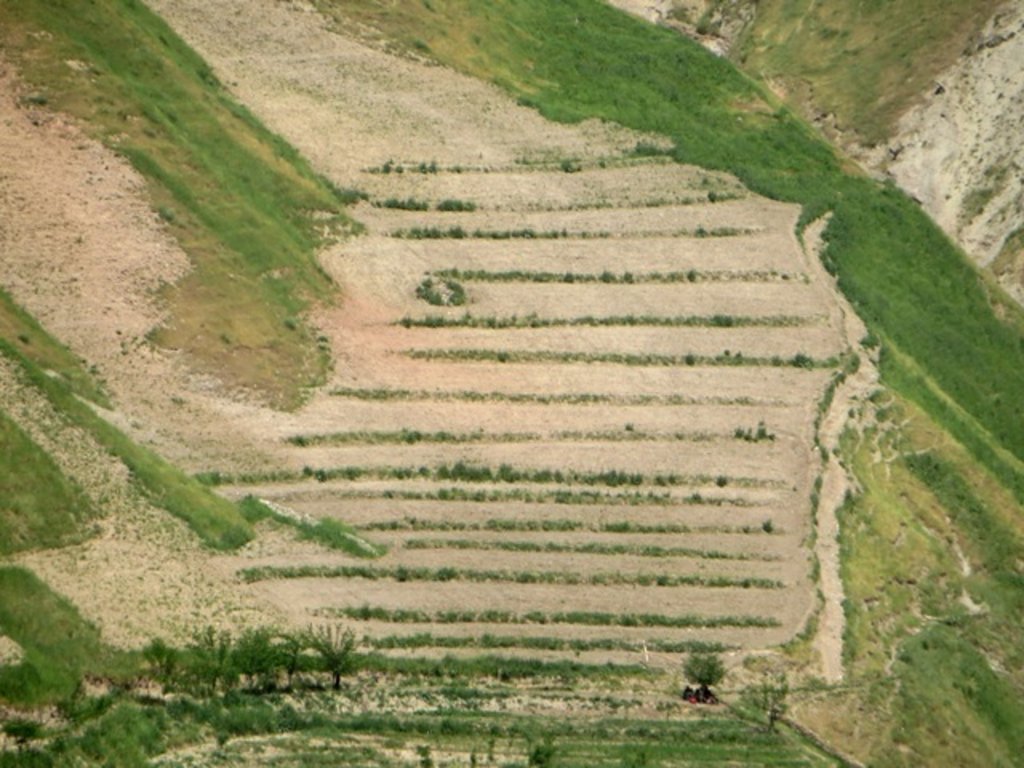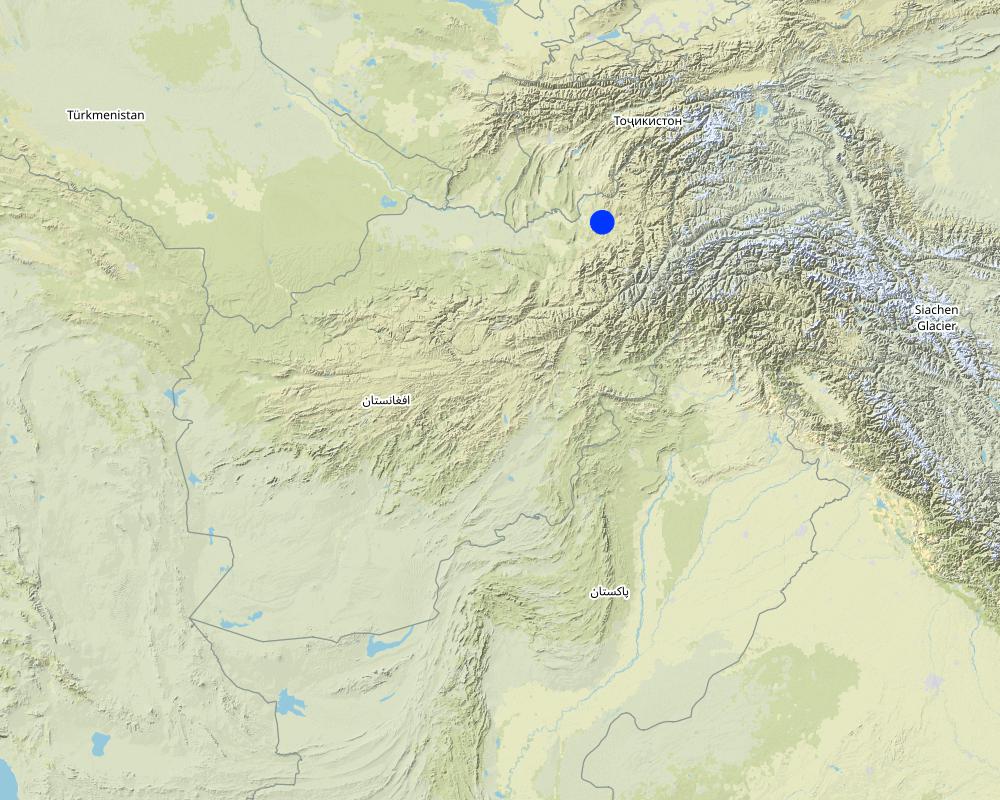Contour hedgerows of alfalfa in annual cropland [Afghanistan]
- Creation:
- Update:
- Compiler: Bettina Wolfgramm
- Editors: Roziya Kirgizbekova, Aslam Qadamov, Aqila Haidery
- Reviewer: William Critchley
Khati sabz, Qamarbandi sabz
technologies_670 - Afghanistan
View sections
Expand all Collapse all1. General information
1.2 Contact details of resource persons and institutions involved in the assessment and documentation of the Technology
Key resource person(s)
land user:
Mohammad Azim Habibullah
Natural Resources Management Comittee (NRMC)
Sari Joy Village, Rustaq District, Takhor Province
Afghanistan
SLM specialist:
Maroofi Mia Jan
+93 700 019 054
mia.maroofi@gmail.com
Livelihood Improvement Program Takhor Afghanistan
Tdh Office Behind Jamai Masjed, Rustaq Town, Takhor Province
Afghanistan
SLM specialist:
Researcher:
Name of project which facilitated the documentation/ evaluation of the Technology (if relevant)
Potential and limitations for improved natural resource management (NRM) in mountain communities in the Rustaq district, Afghanistan (Rustaq NRM Study)Name of project which facilitated the documentation/ evaluation of the Technology (if relevant)
Livelihood Improvement Project Takhar, Afghanistan (LIPT)Name of the institution(s) which facilitated the documentation/ evaluation of the Technology (if relevant)
Terre des Hommes (Terre des Hommes) - SwitzerlandName of the institution(s) which facilitated the documentation/ evaluation of the Technology (if relevant)
Swiss Agency for Development and Cooperation (DEZA / COSUDE / DDC / SDC) - SwitzerlandName of the institution(s) which facilitated the documentation/ evaluation of the Technology (if relevant)
CDE Centre for Development and Environment (CDE Centre for Development and Environment) - SwitzerlandName of the institution(s) which facilitated the documentation/ evaluation of the Technology (if relevant)
Bern University of Applied Sciences, School of Agricultural, Forest and Food Sciences (HAFL) - Switzerland1.3 Conditions regarding the use of data documented through WOCAT
When were the data compiled (in the field)?
27/10/2016
The compiler and key resource person(s) accept the conditions regarding the use of data documented through WOCAT:
Yes
1.4 Declaration on sustainability of the described Technology
Is the Technology described here problematic with regard to land degradation, so that it cannot be declared a sustainable land management technology?
No
Comments:
SLM practices documented in the frame of the Rustaq NRM study were established only recently (1-3 years ago). It is too early for a final judgment on the sustainability of these technologies within the human and natural environment of Chokar watershed.
2. Description of the SLM Technology
2.1 Short description of the Technology
Definition of the Technology:
Hedgerows are vegetative strips of perennial grasses, shrubs or legumes - such as alfalfa - located along contours across a slope. These vegetative strips form a barrier to halt soil erosion and improve soil fertility. Hedgerows of alfalfa also provide quality animal fodder for a period of 5-10 years.
2.2 Detailed description of the Technology
Description:
Project supported implementation of hedgerows has taken place in the villages of Sari Joy and Jawaz Khana, located in Chokar watershed of Rustaq District in Northern Afghanistan. The Chokar watershed is a mountainous area situated between 600 m and 2,500 m above sea level. The climate is semi-arid with harsh and cold weather in winter and hot and dry summers. The annual precipitation in average years is 580mm. Land degradation affects all forms of land use and includes sparse vegetation cover, severe top soil erosion through rainfall runoff, and poor soil fertility. Unsustainable agricultural practices, and over-exploitation of the natural resources are adversely impacting the socio-economic well-being of local communities, as well as contributing to the risk of being adversely affected by drought, landslides and flash foods triggered by heavy rainfall. The data used for the documentation of the technology are based on field research conducted in Chokar watershed, namely in the villages of Sari Joy and Jawaz Khana. These villages represent the upper and the middle zone of Chokar watershed, respectively. They differ considerably in access to services and infrastructure, but in general are poorly served. The communities depend on land resources for sustaining their livelihoods. In a good year with high yields, wheat self-sufficiency lasts about 5 months. The three villages are home to ethnic Qarluq communities. Since 2012 the Livelihood Improvement Project Takhar (LIPT) implemented by Terre des hommes (Tdh) Switzerland has initiated a range of NRM interventions.
Hedgerows are vegetative strips, planted as contour barriers. In this case they are composed of the perennial legume alfalfa (sometime called lucerne: Medicago sativa), Using an A-frame, contours are defined and demarcated horizontally across the hillside. The distance between the contours depends on the slope gradient. For moderate slopes above 6%, and hilly slopes below 30%, the distance between the contours is 4-5 meters. Using such contouring measurements, a plot area of 0.2 ha is divided into 8 hedgerows along the slope. Once all the contours are established, the topsoil is levelled using a shovel. On each marked contour a soil ridge is created, some 10-20 cm high. On these ridges alfalfa seeds are sown to form the vegetative hedgerow. This stops soil wash, and prevents most of the rainfall runoff. The area between the grass strips is cropped with wheat. The hedgerows are protected for one year, to allow the alfalfa to become established.
Hedgerows were introduced in the local villages to promote low-cost land management practices, which are sustainable and well adapted to the local environmental conditions. Apart from reducing soil erosion, this new practice takes into account the needs of local people to improve soil fertility and increase agricultural yields. Local land users were trained to establish hedgerows on their own land using low amount of inputs. They were given the technical knowledge required. Over the past four years of implementation the land users report noticeable improvements on their plots. The soil is protected from erosion, and the households harvest wheat for the family and alfalfa for their livestock.
One of the key benefits of the technology is that it does not require many or costly inputs and it is relatively easy to establish without technical support. Improved production and availability of alfalfa is a primary benefit from the land users' point of view. They can harvest fodder from the plot for up to 10 years without reseeding.
Hedgerows are among the least labour-intensive SLM practices and thereby do not have a significant influence on the daily household workload of local women. This feature of the technology is perceived as its strength by many female family members.
2.3 Photos of the Technology
2.5 Country/ region/ locations where the Technology has been applied and which are covered by this assessment
Country:
Afghanistan
Region/ State/ Province:
Takhar Province, Rustaq District
Further specification of location:
Sari Joy and Jawaz Khana Villages
Comments:
This documentation is based on the experiences of SLM implementers from Sari Joy (3 plots) and Jawaz Khana, (3 plots) as compiled during FGDs. Additionally insights were gained through interviews in the villages on farmers experiences and observations of hedgerow plots, with both SLM implementers (5) and observers (7).
Map
×2.6 Date of implementation
If precise year is not known, indicate approximate date:
- less than 10 years ago (recently)
2.7 Introduction of the Technology
Specify how the Technology was introduced:
- through projects/ external interventions
Comments (type of project, etc.):
Livelihood Improvement Project Takhar (LIPT) implemented by Terre des Hommes (Tdh) Switzerland, supported by Swiss Development Cooperation (SDC) from 2012-17
3. Classification of the SLM Technology
3.1 Main purpose(s) of the Technology
- improve production
- reduce, prevent, restore land degradation
3.2 Current land use type(s) where the Technology is applied

Mixed (crops/ grazing/ trees), incl. agroforestry
- Agroforestry
Main products/ services:
Alfalfa, wheat (ferula in later years)
3.3 Further information about land use
Water supply for the land on which the Technology is applied:
- rainfed
Number of growing seasons per year:
- 1
3.4 SLM group to which the Technology belongs
- integrated soil fertility management
- cross-slope measure
3.5 Spread of the Technology
Specify the spread of the Technology:
- evenly spread over an area
If the Technology is evenly spread over an area, indicate approximate area covered:
- 0.1-1 km2
3.6 SLM measures comprising the Technology

vegetative measures
- V1: Tree and shrub cover

structural measures

management measures
- M1: Change of land use type
Comments:
After establishment activities the area is put on quarantine for one year.
3.7 Main types of land degradation addressed by the Technology

soil erosion by water
- Wt: loss of topsoil/ surface erosion

soil erosion by wind
- Et: loss of topsoil

biological degradation
- Bc: reduction of vegetation cover
- Bq: quantity/ biomass decline
3.8 Prevention, reduction, or restoration of land degradation
Specify the goal of the Technology with regard to land degradation:
- reduce land degradation
4. Technical specifications, implementation activities, inputs, and costs
4.1 Technical drawing of the Technology
Author:
Aslam Qadamov; Roziya Kirgizbekova
Date:
15/02/2017
4.2 Technical specifications/ explanations of technical drawing
Hedgerows are vegetative strips, planted as contour barriers. In this case they are composed of the perennial legume alfalfa (sometime called lucerne: Medicago sativa), Using an A-frame, contours are defined and demarcated horizontally across the hillside. The distance between the contours depends on the slope gradient. For moderate slopes above 6%, and hilly slopes below 30%, the distance between the contours is 4-5 meters. Using such contouring measurements, a plot area of 0.2 ha is divided into 8 hedgerows along the slope. Once all the contours are established, the topsoil is levelled using a shovel. On each marked contour a soil ridge is created, some 10-20 cm high. On these ridges alfalfa seeds are sown to form the vegetative hedgerow. This stops soil wash, and prevents most of the rainfall runoff. The area between the grass strips is cropped with wheat. The hedgerows are protected for one year, to allow the alfalfa to become established.
4.3 General information regarding the calculation of inputs and costs
Specify how costs and inputs were calculated:
- per Technology area
Indicate size and area unit:
1 ha
Specify currency used for cost calculations:
- US Dollars
Indicate exchange rate from USD to local currency (if relevant): 1 USD =:
67.0
Indicate average wage cost of hired labour per day:
5.2-5.3 USD per day
4.4 Establishment activities
| Activity | Type of measure | Timing | |
|---|---|---|---|
| 1. | Selection of the area for establishing a hedgerow | Management | End of autumn |
| 2. | Design of the hedgerows using an A-frame | Structural | End of autumn |
| 3. | Leveling of the land | Agronomic | End of autumn |
| 4. | Alfalfa seed sowing | Vegetative | End of winter (February) |
| 5. | Area under protection | Management | For one year |
4.5 Costs and inputs needed for establishment
| Specify input | Unit | Quantity | Costs per Unit | Total costs per input | % of costs borne by land users | |
|---|---|---|---|---|---|---|
| Labour | Designing of the hedgerow using A-frame | person-day | 5.0 | 9.0 | 45.0 | |
| Labour | Leveling the land | person-day | 25.0 | 5.3 | 132.5 | |
| Labour | Ploughing the land with animal traction | person-day | 5.0 | 5.3 | 26.5 | |
| Labour | Wheat and Alfalfa seed sowing | person-day | 10.0 | 5.3 | 53.0 | 100.0 |
| Equipment | Rake | piece | 1.0 | 5.3 | 5.3 | |
| Equipment | Shovel | piece | 1.0 | 3.8 | 3.8 | |
| Equipment | Twine | meter | 50.0 | 2.0 | 100.0 | |
| Equipment | A-frame | piece | 1.0 | 6.0 | 6.0 | |
| Plant material | Alfalfa seed | Kg | 17.5 | 0.42 | 7.35 | |
| Plant material | Wheat seed | Kg | 140.0 | 0.42 | 58.8 | 100.0 |
| Fertilizers and biocides | DAP | Kg | 250.0 | 0.9 | 225.0 | |
| Fertilizers and biocides | Urea | Kg | 250.0 | 0.45 | 112.5 | |
| Fertilizers and biocides | Herbicide | Liter | 50.0 | 0.25 | 12.5 | |
| Total costs for establishment of the Technology | 788.25 | |||||
If land user bore less than 100% of costs, indicate who covered the remaining costs:
Livelihood Improvement Program in Takhar (LIPT) implemented by Terre des hommes (Tdh)
Comments:
Costs calculated for a Technology area of 1ha was only done for the purpose of the WOCAT documentation. In reality SLM plots are on average 0.2-0.4 ha or 1-2 jiribs. Costs were simply multiplied by 2.5. The actual costs for a 1ha plot might be slightly different.
4.6 Maintenance/ recurrent activities
| Activity | Type of measure | Timing/ frequency | |
|---|---|---|---|
| 1. | Ploughing the land with animal traction (Men) | Agronomic | |
| 2. | Wheat sowing | Agronomic | |
| 3. | Weeding | Agronomic | |
| 4. | Fertilizer application | Agronomic | |
| 5. | Repair the damaged section of the hedgerow by adding soil | Structural | End of winter (February/March) |
| 6. | Reseeding alfalfa in the repaired section | Vegetative | End of winter (February/March) |
| 7. | Wheat and alfalfa harvesting and delivering | Agronomic |
Comments:
Sowing of alfalfa is done once in 5-10 years. The maintenance activities do not require reseeding of alfalfa every year (only where damaged). Mostly damage to hedgerows occur as a result of heavy rainfall and require maintenance work in early spring.
4.7 Costs and inputs needed for maintenance/ recurrent activities (per year)
| Specify input | Unit | Quantity | Costs per Unit | Total costs per input | % of costs borne by land users | |
|---|---|---|---|---|---|---|
| Labour | Ploughing the land with animal traction | person day | 5.0 | 5.3 | 26.5 | 100.0 |
| Labour | Sowing of wheat | person day | 5.0 | 5.3 | 26.5 | 100.0 |
| Labour | Weeding and Fertilizer application | person day | 5.0 | 5.3 | 26.5 | 100.0 |
| Labour | Harvesting and delivering wheat and alfalfa | person day | 35.0 | 3.0 | 105.0 | 100.0 |
| Equipment | Sickle | Pcs | 1.0 | 2.25 | 2.25 | 100.0 |
| Equipment | Pitchfork | Pcs | 1.0 | 5.3 | 5.3 | 100.0 |
| Plant material | Alfalfa seed | kg | 1.0 | 0.42 | 0.42 | 100.0 |
| Plant material | Wheat seed | kg | 140.0 | 0.42 | 58.8 | 100.0 |
| Fertilizers and biocides | DAP | Kg | 250.0 | 0.9 | 225.0 | 100.0 |
| Fertilizers and biocides | Urea | Kg | 250.0 | 0.45 | 112.5 | 100.0 |
| Total costs for maintenance of the Technology | 588.77 | |||||
If land user bore less than 100% of costs, indicate who covered the remaining costs:
Livelihood Improvement Program in Takhar (LIPT) implemented by Terre des hommes (Tdh)
Comments:
Costs calculated for a Technology area of 1ha was only done for the purpose of the WOCAT documentation. In reality SLM plots are on average 0.2-0.4 ha or 1-2 jiribs. Costs were simply multiplied by 2.5. The actual costs for a 1ha plot might be slightly different.
4.8 Most important factors affecting the costs
Describe the most determinate factors affecting the costs:
Due to the remoteness of the villages where the Technology has been implemented, all the inputs for establishment, such as plant material, fertilizers and agricultural tools are purchased in Rustaq town. The expenses for traveling and delivering the inputs affect the establishment costs.
5. Natural and human environment
5.1 Climate
Annual rainfall
- < 250 mm
- 251-500 mm
- 501-750 mm
- 751-1,000 mm
- 1,001-1,500 mm
- 1,501-2,000 mm
- 2,001-3,000 mm
- 3,001-4,000 mm
- > 4,000 mm
Specify average annual rainfall (if known), in mm:
564.00
Specifications/ comments on rainfall:
Average annual precipitation for the area was calculated with 564 mm, with minimum in dry years (2000 and 2001) of 270 mm and maximum in wet years (2009/2010) of 830 mm. The absolute maximum rainfall was calculated for 1986 with 1024 mm. The data series covers the period from 1979 to 2014.
Indicate the name of the reference meteorological station considered:
Climate Forecast System Reanalysis (CFSR), http://rda.ucar.edu/pub/cfsr.html
Agro-climatic zone
- semi-arid
Derived from the publicly available dataset on length of growing period (LGP) (Fischer 2009 / IIASA-FAO). Internet link: http://tiles.arcgis.com/tiles/P8Cok4qAP1sTVE59/arcgis/rest/services/Length_of_growing_period/MapServer
5.2 Topography
Slopes on average:
- flat (0-2%)
- gentle (3-5%)
- moderate (6-10%)
- rolling (11-15%)
- hilly (16-30%)
- steep (31-60%)
- very steep (>60%)
Landforms:
- plateau/plains
- ridges
- mountain slopes
- hill slopes
- footslopes
- valley floors
Altitudinal zone:
- 0-100 m a.s.l.
- 101-500 m a.s.l.
- 501-1,000 m a.s.l.
- 1,001-1,500 m a.s.l.
- 1,501-2,000 m a.s.l.
- 2,001-2,500 m a.s.l.
- 2,501-3,000 m a.s.l.
- 3,001-4,000 m a.s.l.
- > 4,000 m a.s.l.
Comments and further specifications on topography:
-SLM implementers information provided in the Land User Protocol (LUP) during an FGD
-Elevation and slope statistics derived for terraced plots from ASTGTM. ASTGTM is the ASTER Global Digital Elevation Model V002 with a 30 m spatial resolution. More information on ASTGTM is available here: https://lpdaac.usgs.gov/node/1079. The data can be downloaded here: https://gdex.cr.usgs.gov/gdex/
5.3 Soils
Soil depth on average:
- very shallow (0-20 cm)
- shallow (21-50 cm)
- moderately deep (51-80 cm)
- deep (81-120 cm)
- very deep (> 120 cm)
Soil texture (topsoil):
- medium (loamy, silty)
Soil texture (> 20 cm below surface):
- medium (loamy, silty)
Topsoil organic matter:
- low (<1%)
If available, attach full soil description or specify the available information, e.g. soil type, soil PH/ acidity, Cation Exchange Capacity, nitrogen, salinity etc.
Hedgerows are implemented on light soil - a locally defined category for soil types. Light soil corresponds to moderately deep soil; medium topsoil texture; medium below surface texture and low topsoil organic matter.
5.4 Water availability and quality
Ground water table:
5-50 m
Availability of surface water:
medium
Water quality (untreated):
good drinking water
Is water salinity a problem?
No
Is flooding of the area occurring?
Yes
Regularity:
episodically
Comments and further specifications on water quality and quantity:
Floods occur mainly during the rainy seasons in spring and autumn. Availability of surface water differs for the two study villages Sari Joy and Jawaz Khana. Sari Joy has relatively good surface water availability, also for drinking. Jawaz Khana has poor water both in quality and availability. Water has to be fetched from a lower lying stream.
5.5 Biodiversity
Species diversity:
- low
Habitat diversity:
- low
5.6 Characteristics of land users applying the Technology
Sedentary or nomadic:
- Sedentary
Market orientation of production system:
- subsistence (self-supply)
- mixed (subsistence/ commercial
Off-farm income:
- 10-50% of all income
- > 50% of all income
Relative level of wealth:
- poor
- rich
Individuals or groups:
- individual/ household
Level of mechanization:
- manual work
- animal traction
Gender:
- women
- men
Age of land users:
- children
- middle-aged
Indicate other relevant characteristics of the land users:
The land users in the area where the Technology is applied belong to the Uzbek ethnic minority group Qarluq. Although the men are generally the main land users, however, women and children also take active part in the related work. The functions of men and women are clearly distinguished within the Afghan society. At the same time within the family this division of work and functions also results in men and women working hand-in-hand. An improvement of the family’s livelihood situation is expected to positively affect all family members. While, it is recognized that the involvement of women is key in order to secure basic human rights for everyone, to achieve good governance, sustainable development, and to efficiently contribute to poverty reduction (SDC 2004), it is also clear that a context sensitive approach is of great importance.
Women in rural Afghanistan are involved in many production and income generating activities that contribute to the overall household income, however, very few women own resources such as land and livestock, and their income generating options are fewer in comparison to that of men.
5.7 Average area of land owned or leased by land users applying the Technology
- < 0.5 ha
- 0.5-1 ha
- 1-2 ha
- 2-5 ha
- 5-15 ha
- 15-50 ha
- 50-100 ha
- 100-500 ha
- 500-1,000 ha
- 1,000-10,000 ha
- > 10,000 ha
Is this considered small-, medium- or large-scale (referring to local context)?
- medium-scale
5.8 Land ownership, land use rights, and water use rights
Land ownership:
- individual, not titled
Land use rights:
- individual
Water use rights:
- communal (organized)
Comments:
Those who own a land and use water for irrigation are obliged to pay for water. The payment is made either in kind or in cash to Mirob - the person in charge of distributing water in the community. The amount of the payment varies from village to village.
6. Impacts and concluding statements
6.1 On-site impacts the Technology has shown
Socio-economic impacts
Production
crop production
Comments/ specify:
Wheat grows well on the plot where the contour strips support moisture retention, as well as prevent the seeds and fertilizers to be washed off.
fodder production
Comments/ specify:
Alfalfa is produced on the hedgerows to ensure stable supply of livestock fodder.
animal production
Comments/ specify:
The livestock of the household benefit from the improved production of alfalfa as a fodder crop.
wood production
non-wood forest production
product diversity
production area
Socio-cultural impacts
SLM/ land degradation knowledge
Comments/ specify:
Land users learned how to implement SLM practices.
situation of socially and economically disadvantaged groups
Comments/ specify:
Female headed households are not included. Technology is implemented on private land, therefore people without land are excluded. However, they have the opportunity to earn income as a hired worker for the SLM implementers.
Ecological impacts
Water cycle/ runoff
surface runoff
Soil
soil loss
Biodiversity: vegetation, animals
Vegetation cover
6.2 Off-site impacts the Technology has shown
downstream flooding
downstream siltation
buffering/ filtering capacity
Comments regarding impact assessment:
Based on the Land User Protocols: SLM implementers were asked to rate the benefits from hedgerows individually. They were asked to indicate production increase of crops; fodder; animals; wood; non-wood forest products; increase in product diversity; or production area. The most important increase they rated with 3, the second most with 2, others with 1 point. Averages of the points given by all hedgerow implementers are reflected here.
Based on the Land User Protocols: Individual SLM implementers were asked to rate the on-site and off-site impacts of the Technology on water; soil; and vegetation. They were asked to indicate the strength of impacts with three, two or one points. Averages of the points given by all implementers are reflected here.
6.3 Exposure and sensitivity of the Technology to gradual climate change and climate-related extremes/ disasters (as perceived by land users)
Climate-related extremes (disasters)
Meteorological disasters
| How does the Technology cope with it? | |
|---|---|
| local rainstorm | very well |
Climatological disasters
| How does the Technology cope with it? | |
|---|---|
| drought | well |
Comments:
Based on the multi-criteria matrix: SLM implementers were asked to jointly discuss and rate how much the SLM technology reduced the lands vulnerability to drought and local rainstorms. Only vulnerability to the most prevalent climate extremes (drought and local rainstorms) was discussed. SLM technologies were rated as reducing vulnerability poorly, well, or very well. The average points reflected here are from multi-criteria matrixes compiled in three villages where the SLM technology had been implemented.
6.4 Cost-benefit analysis
How do the benefits compare with the establishment costs (from land users’ perspective)?
Short-term returns:
positive
Long-term returns:
positive
Comments:
SLM implementers from three villages were asked to jointly discuss and rate the SLM technologies short term (1-3 years) and long-term (10 years) return. As most of the technologies have only been implemented 1-2 years ago, it is too early to compare benefits to maintenance costs. Farmers have little experience so far on the actual benefits of the SLM technologies. The ratings are mostly based on expected benefits and not on actual benefits.
6.5 Adoption of the Technology
- single cases/ experimental
If available, quantify (no. of households and/ or area covered):
16.4 ha
Comments:
Based on the Land User Protocol: Individual SLM implementers were asked whether they received support for implementing the Technology. Each indicated the type of support he received from the proposed options: "Full Support 100%, Some Support, No Support 0%".
6.6 Adaptation
Has the Technology been modified recently to adapt to changing conditions?
No
6.7 Strengths/ advantages/ opportunities of the Technology
| Strengths/ advantages/ opportunities in the land user’s view |
|---|
| The contour alfalfa strips preserve moisture and makes the land less vulnerable to dry spells. Longer moisture retention also helps the crop to grow better. |
| Production of livestock fodder such as alfalfa has been improved as observed by the land users. The hedgerow protects the soil from heavy rainfall, which would wash off the topsoil otherwise. |
| The establishment and maintenance activities are well compatible with the daily work of the land user compared to other more demanding field work. |
| Alfalfa can be grown without reseeding for up to 5 years and there is no need to buy alfalfa seeds every year. |
| Hedgerows are considered as the least labour-intensive technology for women and does not impact their daily household activities. |
| Strengths/ advantages/ opportunities in the compiler’s or other key resource person’s view |
|---|
| The establishment of hedgerows is not very technically demanding and does not require great technical knowledge |
6.8 Weaknesses/ disadvantages/ risks of the Technology and ways of overcoming them
| Weaknesses/ disadvantages/ risks in the land user’s view | How can they be overcome? |
|---|---|
| The costs of establishment are high for the land user, including the labour and material inputs | |
| The alfalfa strips need to be reseeded in 5-10 years and the land user may not have the seeds and has to buy them himself |
| Weaknesses/ disadvantages/ risks in the compiler’s or other key resource person’s view | How can they be overcome? |
|---|---|
| Hedgerows are among least popular practices among the land users and the adoption rates have been very low. The reasons behind might be the high establishments costs. |
7. References and links
7.1 Methods/ sources of information
- field visits, field surveys
No field work was conducted.
- interviews with land users
Focus group discussions (FGD) were organized by the CDE team to collect information from SLM implementers. Total of 6 land users who have implemented hedgerows participated in the FGDs held in the villages of Sari Joy and Jawaz Khana.
Interviews were conducted by the HAFL team to collect information from persons representing all the three study villages. Very detailed interviews were conducted with 12 persons interested in hedgerows implementation, of which 5 persons are from households that already have implemented hedgerows.
- interviews with SLM specialists/ experts
Close collaboration took place during the compilation of this material with the technical staff of the LIPT project in Rustaq.
- compilation from reports and other existing documentation
Information provided in the reports of the LIPT project in Rustaq served as an initial source of information during the preparatory phase and also solidifying the description of the technology and area of implementation. Other background papers on Afghanistan were referred to for general information on agriculture and natural resource management in Afghanistan.
7.2 References to available publications
Title, author, year, ISBN:
Guidelines for Focus Groups Discussions
Title, author, year, ISBN:
Methods section of the Rustaq NRM study
Links and modules
Expand all Collapse allLinks
No links
Modules
No modules


